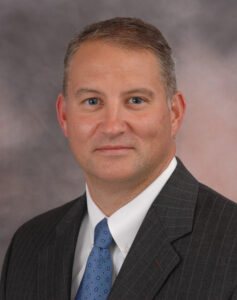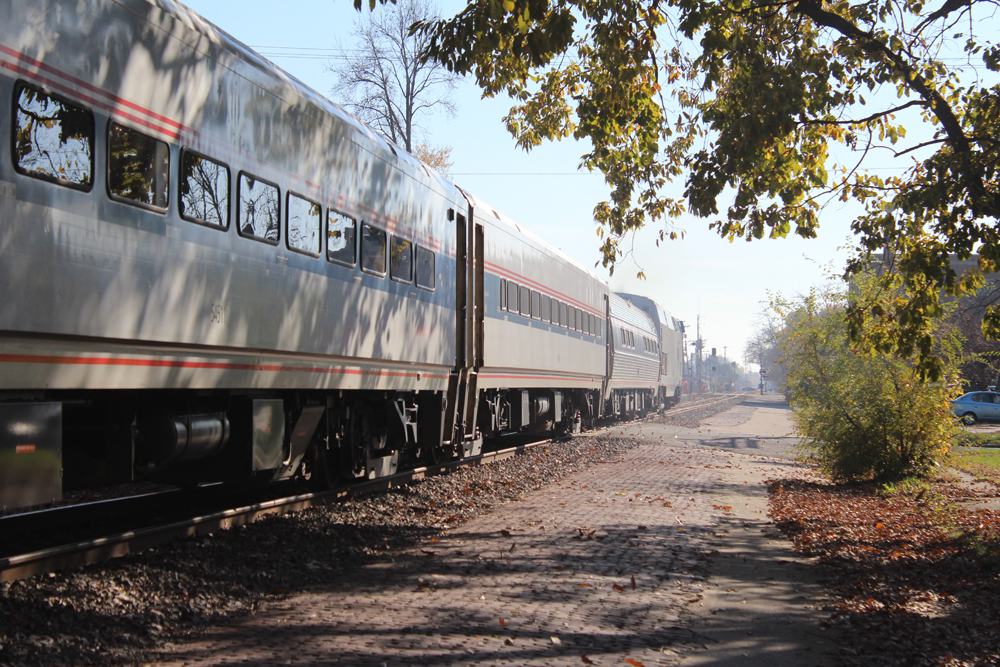PITTSBURGH — Railroads need to collaborate and take a long-term view if they are to make the most of their traffic growth opportunities, Michael Miller, president of Genesee & Wyoming’s North American operations, told a shipper conference on Wednesday.
“We as an industry have always looked at it as ‘What’s in it for me? What’s in it for my company? What’s in it for us?’” Miller told the North East Association of Rail Shippers. “And quite honestly, we have to look more broadly and think about how do we make this ecosystem work better?”

Class I railroads, short lines, shippers, partners, and suppliers all need to work together on solutions that can help the industry grow, Miller says.
“We tend to make decisions that impact our own businesses. And that has a ripple effect across the ecosystem,” he says. “We need to stop doing that. We need to sit down and have conversions with people and be transparent with people. We need to think about the decisions we make and the ripple effect it has on the ecosystem.”
If railroads do that, he says, they’ll be able to provide more consistent service, gain more business, and capitalize on the environmental and physical plant advantages they have over trucks. “Those are critically important to our long-term success,” Miller says.
Railroads have lagged the trucking industry on providing real-time, GPS-based tracking. The RailPulse car-monitoring joint venture involving G&W, Norfolk Southern, Union Pacific, Watco, GATX, Greenbrier, and TrinityRail is an example of the type and level of collaboration and transparency that’s required, Miller says.
“And when you collaborate don’t think about next month. Think about next year. Think about two years from now. How do we create long term win-win solutions? A lot of times I find ourselves making decisions just based upon today, tomorrow, and next month,” Miller says. “That decision has a long-term impact on how big, how good, how far we can go two to three years from now.”
An example, he says, is how railroads made short-term decisions to scrap freight cars as scrap steel prices soared over the past 12 months. Yet some railroad customers can’t find enough freight cars to ship as much via rail as they’d like, Miller says. So some shippers have rescued cars from scrap yards because it was cheaper than continuing to ship by truck, he says.
If the railroad industry took a longer-term view, it would better balance the interests of their partners, customers, suppliers, and investors, Miller contends.
Close collaboration with Class I railroads and other short lines has helped G&W grow.
G&W and Canadian National partner on a short-haul move of Ford auto parts between the automaker’s Buffalo (N.Y.) Stamping Plant and the Ford assembly plant in Oakville, Ontario, near Toronto.
The railroads are competitive with trucks on a haul of just under 100 miles because G&W’s South Buffalo Railway blocks the traffic bound for CN destinations in Sarnia, Oakville, and Toronto, Miller says. And that allows the cars to make cross-border Buffalo-Oakville round trips in just three days, he says.
G&W’s Providence & Worcester partners with Anacostia Rail Holdings’ New York & Atlantic for unit train moves of aggregates to Long Island from quarries in Connecticut.
“If our Providence & Worcester Railroad didn’t work with James Bonner at the New York & Atlantic Railroad, we wouldn’t be able to create a supply chain solution that meets the needs of our quarry customers,” Miller says. “Some days I’m hollering at Mr. Bonner and some days he’s hollering at us because our service isn’t good. But we know we have to work together to deliver that product for our customer.”
Some days some parts of the rail ecosystem will win, and other days they will lose, Miller says. But if everyone takes a longer term and more cooperative view, the industry will be better off and able to grow, he says.
— Updated at 9:55 a.m. to correct name of New York & Atlantic President James Bonner.














The problem is getting WALL STREET to think long term…they used to, decades ago, then it became what can you do for me this quarter? The problem doesn’t lie with the Class 1’s, shippers, etc.,…it can all be traced to WALL STREET.
I used to think that was the primary challenge facing class 1’s, but how can you explain G&W’s CEO making these comments and providing examples of executing these strategies in his business units when Genessee and Wyoming is publicly traded just like the class 1’s, save BNSF?
Because while G&W is a 1.5 billion revenue company, it is made up of 114 railroad units. Those 114 units all have their own set of books that is too difficult for a Wall Streeter to squeeze. I would reckon that the OR on all of these units covers a very large range that is just too hard to aggregate into a single value point.
Class 1’s are easier to squeeze because they are large and a single unit.
How can a hedge fund squeeze a GW exec and say “hey, Hooterville & Eastern only made $200,000 last year, tell them to cut costs and stop servicing the Shady Rest”. No hedger would waste their time.
Squeezing G&W is like hitting a hundred singles and doubles just to get a run, whereas squeezing a Class 1 is like hitting home runs. Quicker returns, less energy required.
We (G&W) have not been publicly traded since 12/30/19 when Brookfield Infrastructure and GIC completed their acquisition, so we cannot be ‘squeezed’ by the Street, at least not directly. Michael Miller is President; Jack Hellmann is CEO. Ford Motor is one of my accounts on the Buffalo & Pittsburgh (BPRR). The Buffalo – Oakville rail traffic works well and is a win-win-win situation for BPRR, CN and Ford Motor.
Touche! I thought they were still public as well! No wonder they can push long term.
Preaching to the choir. Think back to the UP meltdown after tossing out all of the SP folks who knew how to run their railroad and make it function. Think back also the the NS near-meltdown after the Conrail bust-up; they shoved their “perfect: operating system” down the throats of the CR guys and started a palace rebellion. Are the the big-shot CEO’s and COO’s any different now? Hah!
Not only the railroads. Look at Ford Motor Company. Read the news coverage. Half the news is Ford cars catching on fire. The other half of news articles is FoMoCo laying off 3,000 white collar staff every few months and demolishing redundant buildings at the tech center at Dearborn and Allen Park.
Of course Ford needs to bankrupt itself for the Michigan Central Station project in Detroit. Because it needs the space for its former employees. After all, who needs an obsolete 1960’s tech building in Dearborn or Allen Park when it can be replaced by an ultra-modern 1910’s train station.
Interesting concept, Mr. Miller.
The challenge here is Class I thinking. “Thinking” is a relative term. The Class I’s think in terms of the current or next quarterly profit reports. That is the way Wall Street works.
Have you talked with the CEOs of the Class I railroads about this concept? Will they even talk to you?
I wish you the best.
Welcome wise words from a man who knows of what he speaks. I hope the C1’s listen. But suspect their minds won’t accept what he says.
Well Mr. Miller.. You speak to an actually much broader problem throughout American Society..Polarization. Divided States of America may be a better term….
Gee Braden, as I recall you were one of those people who said short haul rail moves didn’t work when we were talking about inland port shuttle trains. What happened, did reality get in the way???